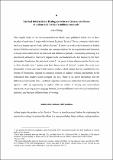Tactical interactions : dialogues between Greece and Rome in the military manuals of Aelian and Arrian
Abstract
This chapter looks at two interconnected texts which were published within two or three decades of each other: Aelianus Tacticus’ Tactical Theory (addressed to Trajan) and Arrian’s Tactics, published two or three decades later under Hadrian. Both texts appear to draw on the same source material, and it is reasonable to suppose that Arrian was aware of Aelian’s earlier treatise, although there is no direct interaction between them. Their different approaches to the same material offer an opportunity to explore different models of literary and cross-cultural interaction, and also to examine our go-to metaphors and interpretative models for analysing them. While Aelian establishes a series of polemical comparisons between age-old Greek military theory and currently effective Roman military practice, Arrian hints at overlaps between Greek and Roman traditions, both by incorporating a section on Roman cavalry manoeuvres and by interacting with a speech delivered by Hadrian to the Roman army at Lambaesis in 128. Both approaches are equally tactical; and both are revealing of the complex dynamics of cross-cultural interaction, which took place on and off the page, and in literary and less literary forms of writing.
Citation
Konig , A R 2020 , Tactical interactions : dialogues between Greece and Rome in the military manuals of Aelian and Arrian . in A König , R Langlands & J Uden (eds) , Literature and Culture in the Roman Empire, 96–235 : Cross-Cultural Interactions . Cambridge University Press , pp. 143-156 , Literary and Cultural Interactions in the Roman Empire: 96-235 (13-14th June, 2016; Exeter) , Exeter , United Kingdom , 13/06/16 . https://doi.org/10.1017/9781108637336.009 other
Publication
Literature and Culture in the Roman Empire, 96–235
Status
Peer reviewed
Type
Book item
Collections
Items in the St Andrews Research Repository are protected by copyright, with all rights reserved, unless otherwise indicated.

